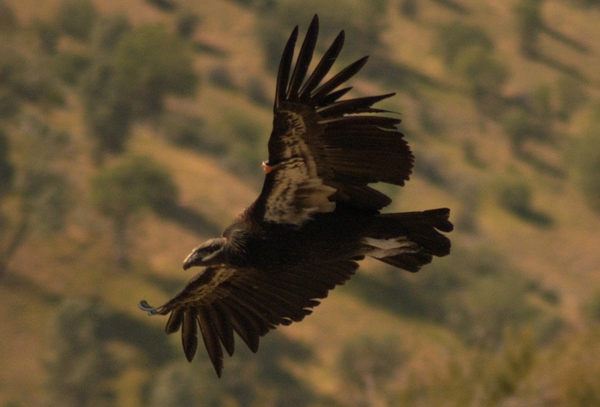
Two of the Pinnacles birds are found dead
The most intensively managed wild animals in North America
suffered a severe setback in recent weeks, as three California
condors
– two from the flock re-introduced to Pinnacles National
Monument – were found dead.
Two of the Pinnacles birds are found dead
The most intensively managed wild animals in North America suffered a severe setback in recent weeks, as three California condors – two from the flock re-introduced to Pinnacles National Monument – were found dead.
The enormous scavengers once soared across North America. In the 20th Century, loss of habitat, loss of the large carcasses they depend on for survival and lead fragments largely from bullets caused a steep decline in their numbers. When less than two dozen were left flying free, the last wild birds were captured and a captive breeding program began.
Today, fewer than 150 of the enormous birds fly free, scattered in flocks based at the Grand Canyon, Big Sur, the Sespe area of Ventura County and Pinnacles. All free-flying birds wear wing tags, and are closely monitored by biologists and volunteers who track their movements and place large prey out for the birds.
While biologists have yet to positively ascertain cause of death among the birds, one was found under a span of power lines in the Big Sur area. A cut on the bird’s leg suggests that the bird collided with a wire. Two condors had collided with the same wires previously, resulting in their deaths, and Pacific Gas and Electric Co. had installed marking devices a year ago.
The first loss was of a juvenile bird, one of three released two weeks prior amidst much fanfare at Pinnacles. The bird, a captive-bred female signated condor 417, appeared to be thriving until it was found dead on May 12.
“Condor 417 was just released,” said Pinnacles Superintendent Eric Brunnemann. “By all reports, it appeared to be behaving normally and we’re all stunned by this sudden turn of events.”
A second member of the Pinnacles flock was found dead on May 17. The bird wore a tiny radio transmitter that automatically signals if the bird shows no movement for eight hours. The bird, condor 307, also was a juvenile. She was found dead in the Big Sur area, with no obvious trauma. A necropsy is being conducted at the San Diego Zoo, according to Pinnacles staff. She was last seen at Pinnacles on May 5 and her last sighting in the Big Sur area was May 14.
“Condor 307 was a member of our oldest cohort, and has been tracked routinely flying between Pinnacles and Big Sur,” Brunnemann said. “Although the death of any condor is a heartfelt sadness, the reintroduction of California condors is a proven success as demonstrated by the birth of a wild-hatched condor chick just last April in Big Sur.”
The Big Sur chick hatched April 6, the first wild-hatched condor in Monterey County in a century. Pinnacles now has 13 free-flying California condors, and visitors frequently see them soaring over the monument’s craggy peaks.
The last of the three condors found dead in recent weeks was a member of the Big Sur flock. Condor 301, a 4-year-old male, was found dead on May 15. Ventana Wildlife Society biologist Sayre Flannagan believes the bird struck a marked power line and suffered fatal injuries.
In the mid-1980s, just 22 California condors were left in the wild. Over public outcry, biologists decided to make a bold move to save the species – birds with wings stretching 10 feet or more, weighing upwards of 20 pounds. All the wild birds were captured, and an intensive – and expensive – breeding program begun.
The program was fraught with early difficulties. Birds that imprinted on humans began habituating fast food parking lots. Others showed no fear of people. Eventually, procedures were developed to render captive-bred birds as close to their wild forebears as possible. The population continues to be sustained through active intervention and captive breeding.
Forty of the free-flying condors in the world call California home today, with a goal of 150 in the state.
Condors evolved to prey on large, dead animals. The arrival of humans with firearms changed their fate for the worse. Fragments of lead bullets may be consumed with carrion, leading to illness and death.









